Abstract
1. Intracellular recordings were made from neurones in intact guinea-pig nodose ganglia in vitro and from acutely isolated adult guinea-pig and rabbit nodose neurons to study a bradykinin (BK)-mediated block of a slow spike after-hyperpolarization (AHPslow) that is prominent in 30-40% of these neurones. 2. BK (100 nM) reversibly blocked the AHPslow, resulting in an ablation of the spike accommodative properties of these neurones. The B1 BK receptor agonist [des-Arg9]-BK did not mimic or prevent the actions of BK. In contrast, the B2 BK receptor antagonist D-Arg-[Hyp3,Thi5,D-Tic7,Oic8]-BK (HOE 140) prevented BK-induced block of the AHPslow and the effect of BK on spike frequency adaptation. 3. The BK block of the AHPslow in acutely dissociated neurones was prevented by indomethacin, indicating that this BK effect was dependent upon a cyclo-oxygenase metabolite intrinsic to these neurones. 4. One to twenty femtomoles of the prostanoids PGE2, PGD2, 9 alpha, 11 beta-PGF2 (a metabolite of PGD2), PGF2 alpha, TxB2 and PGI2 were released spontaneously from a nodose ganglion in 15 min. BK (100 nM) selectively increased PGI2 release 2.8-fold without affecting the release of the other prostanoids. Treatment with 10 microM tranylcypromine (TCP), a putative PGI2 synthase inhibitor, completely prevented the BK-induced release of PGI2. 5. In the presence of 10 microM TCP, BK no longer produced significant effects on the AHPslow. In contrast, 10 microM TCP did not prevent PGI2 from blocking the AHPslow. 6. These results suggest that vagal afferents that exhibit AHPslow also possess the B2 type of BK receptor. Activation of these BK receptors results in the production of PGI2, which in turn controls spike frequency adaptation by affecting the amplitude of the AHPslow.
Full text
PDF
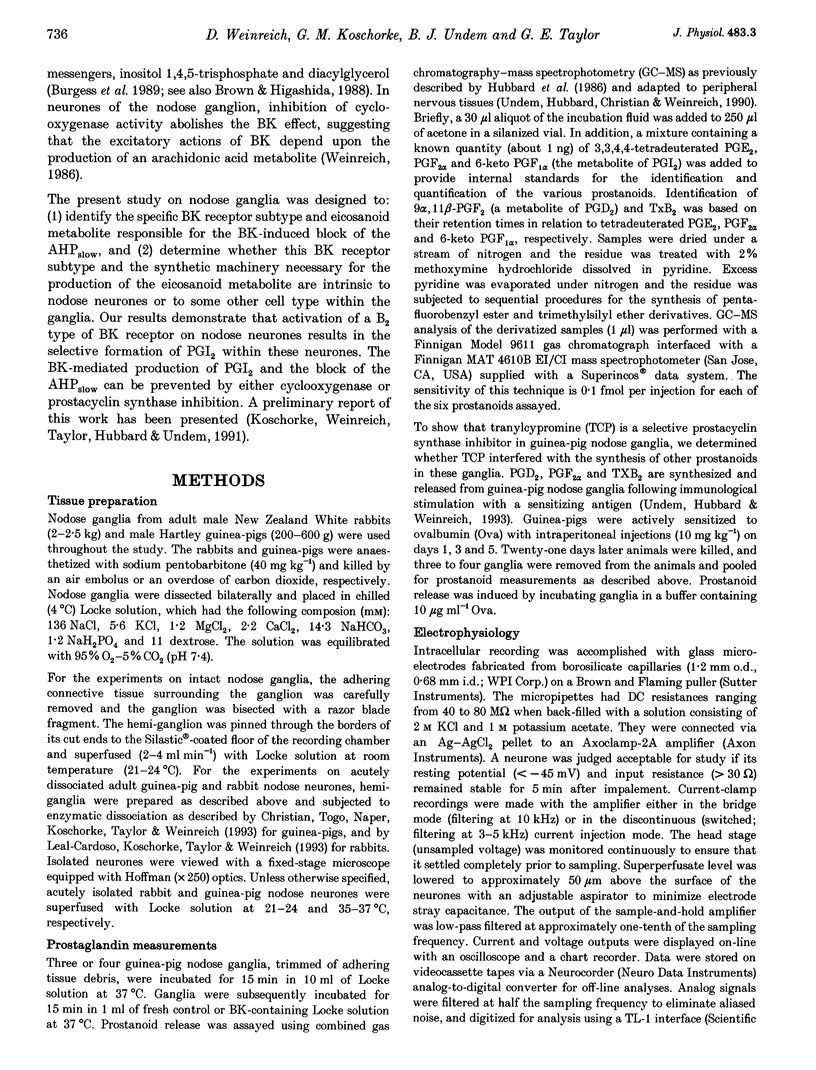
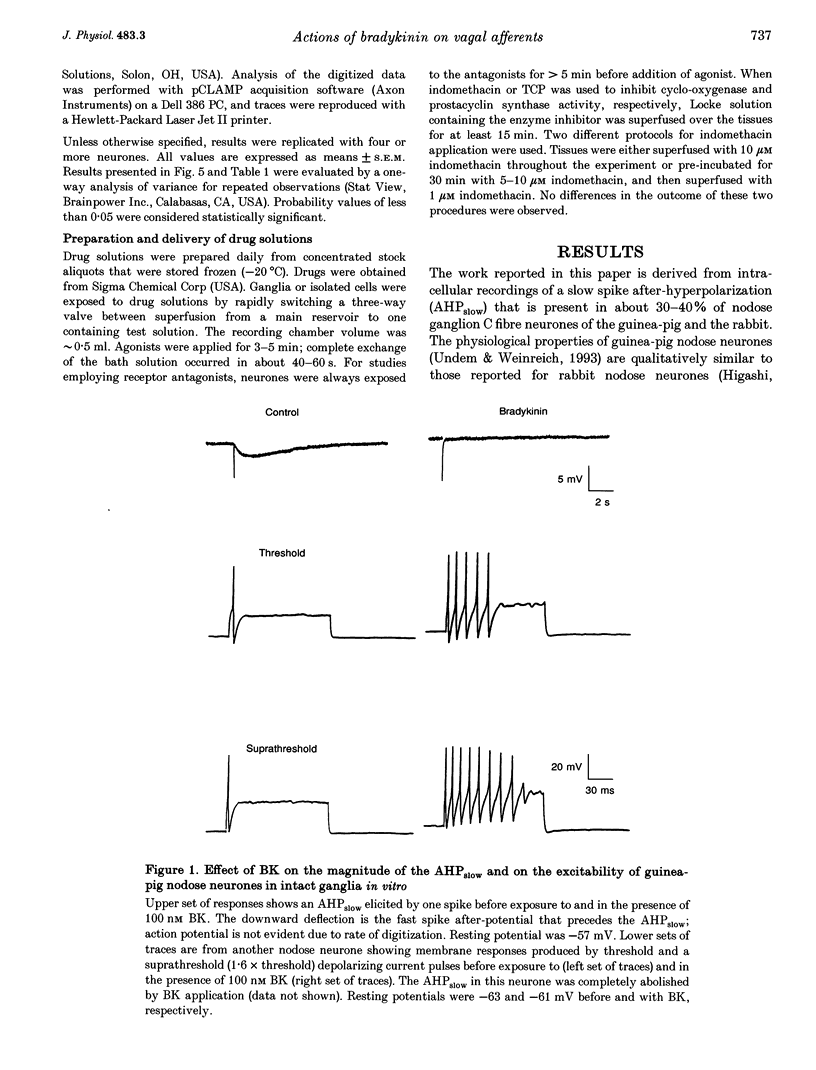
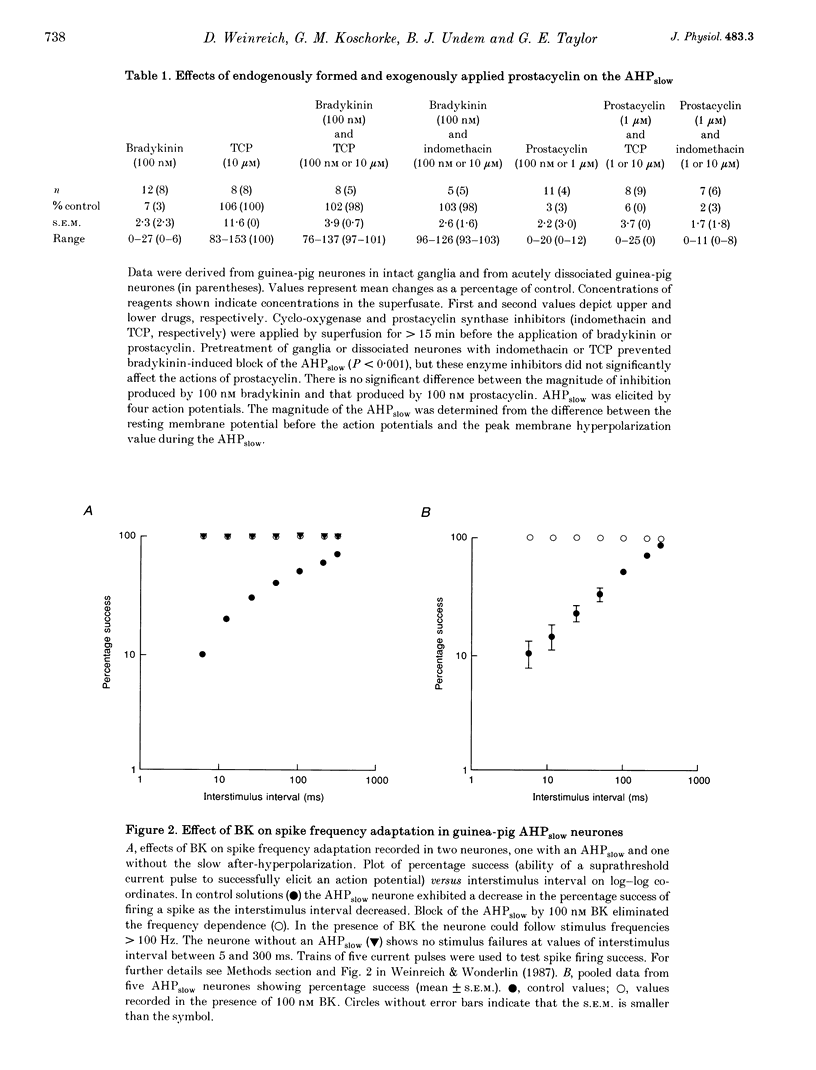
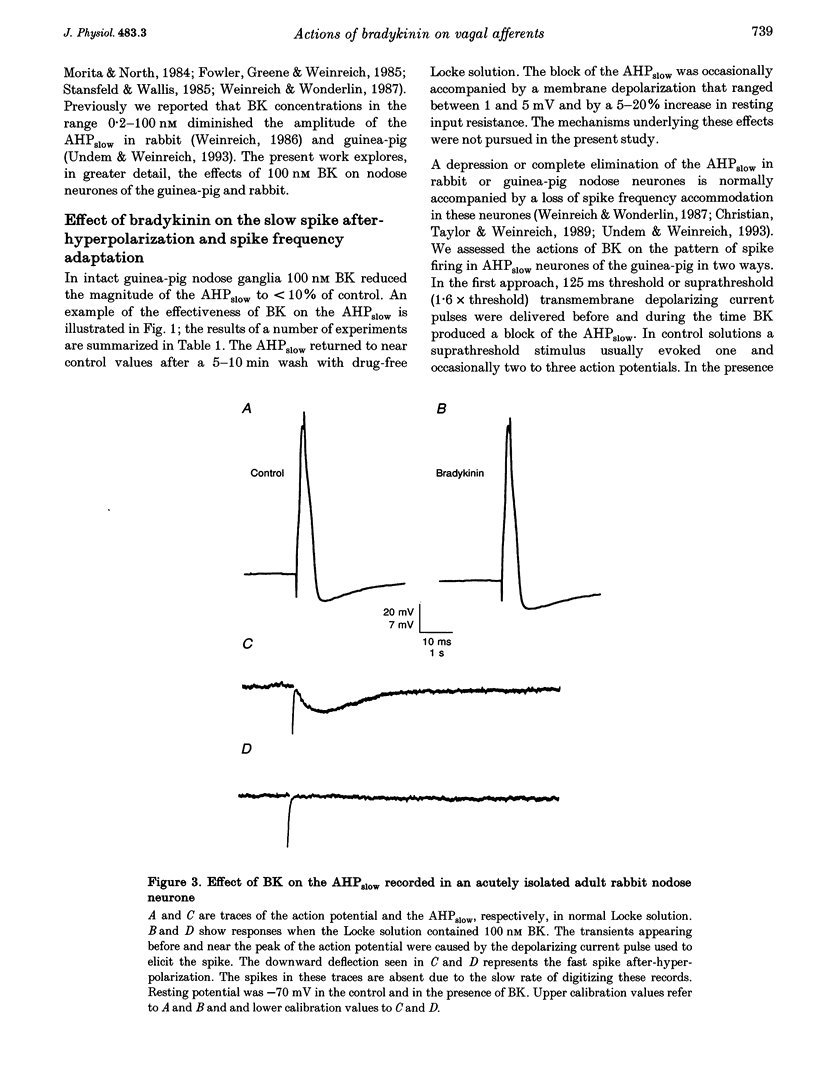

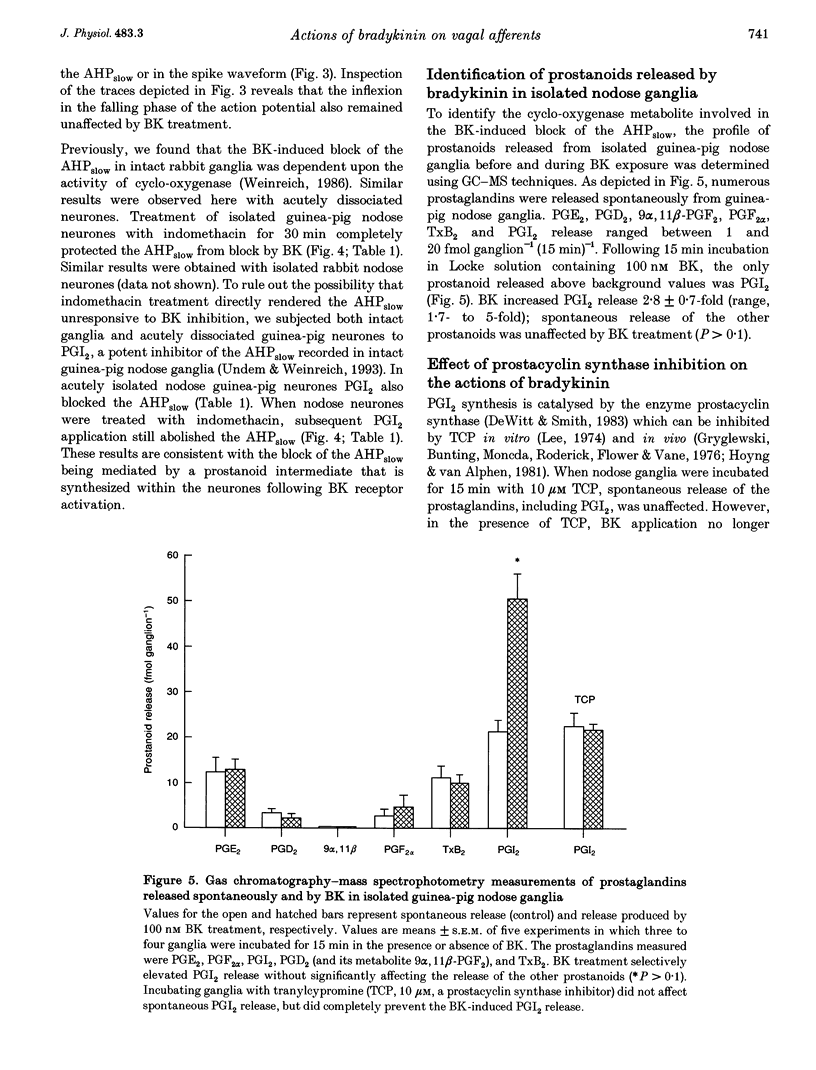
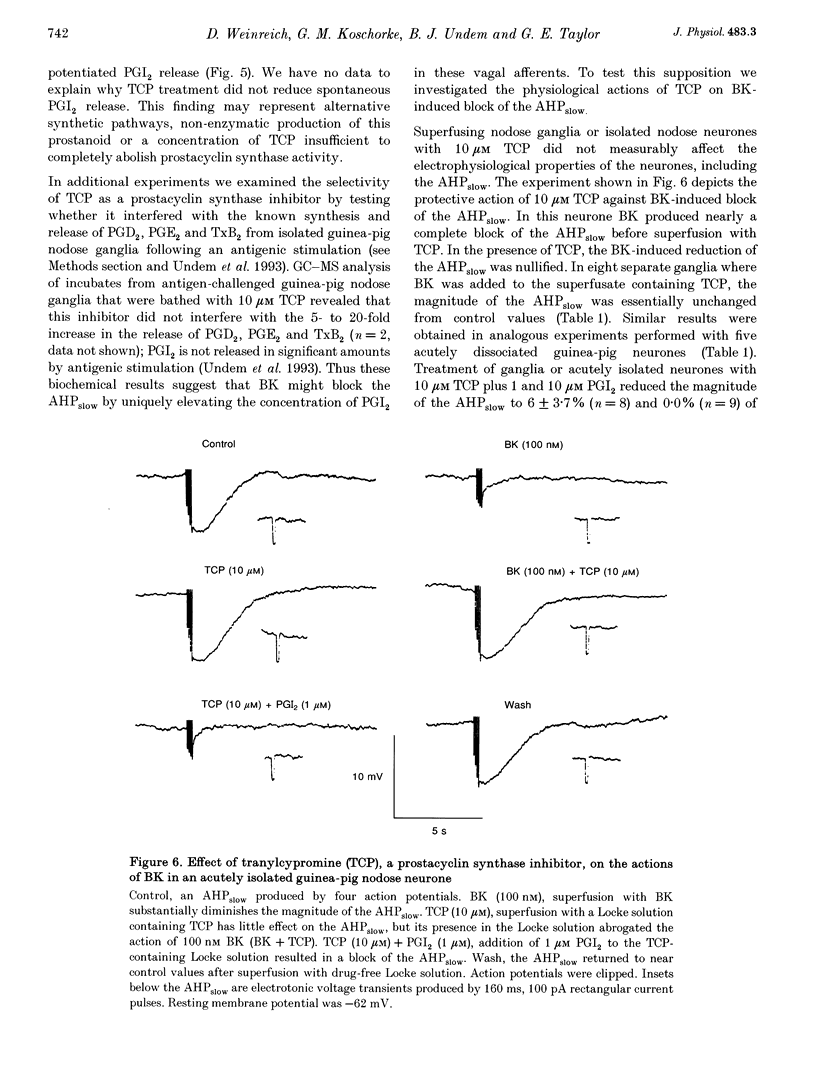
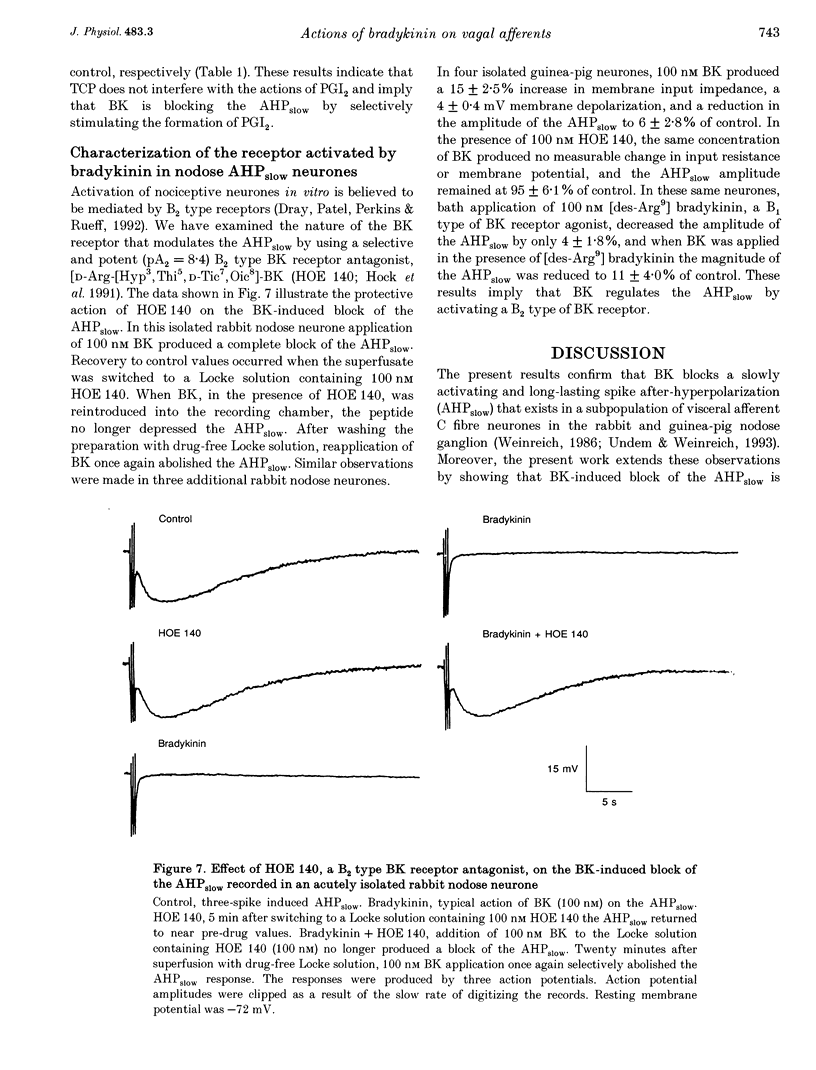
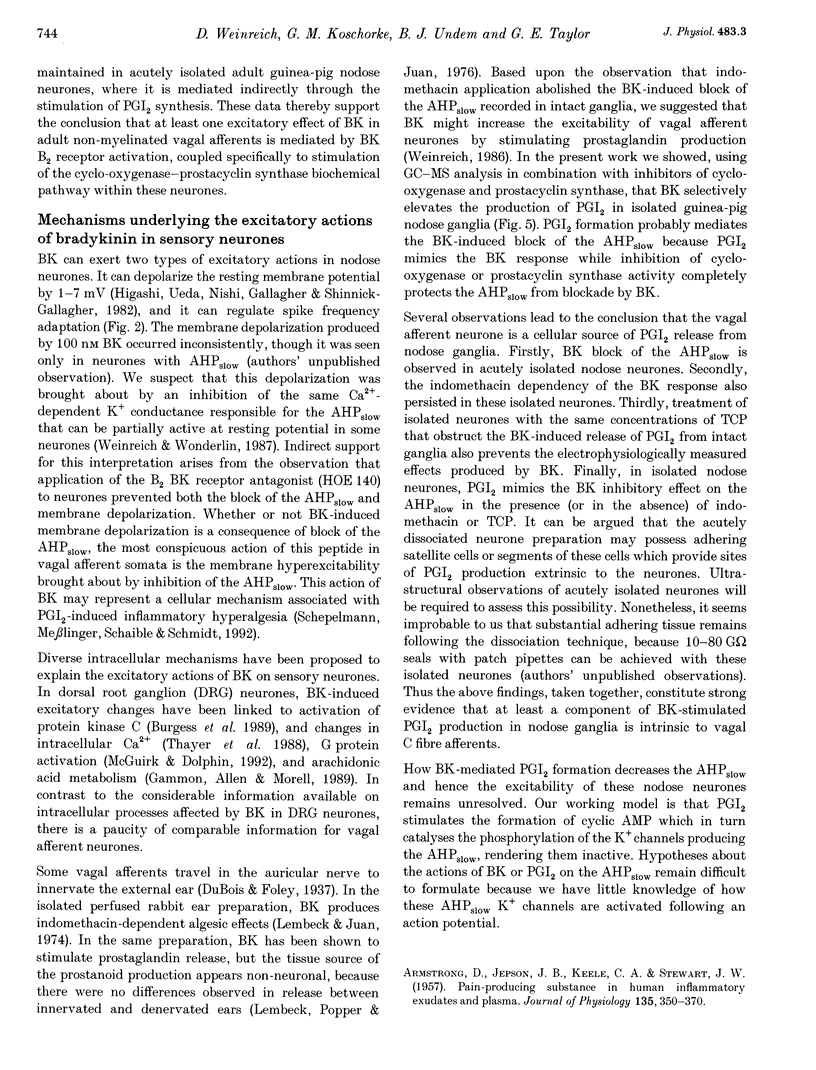
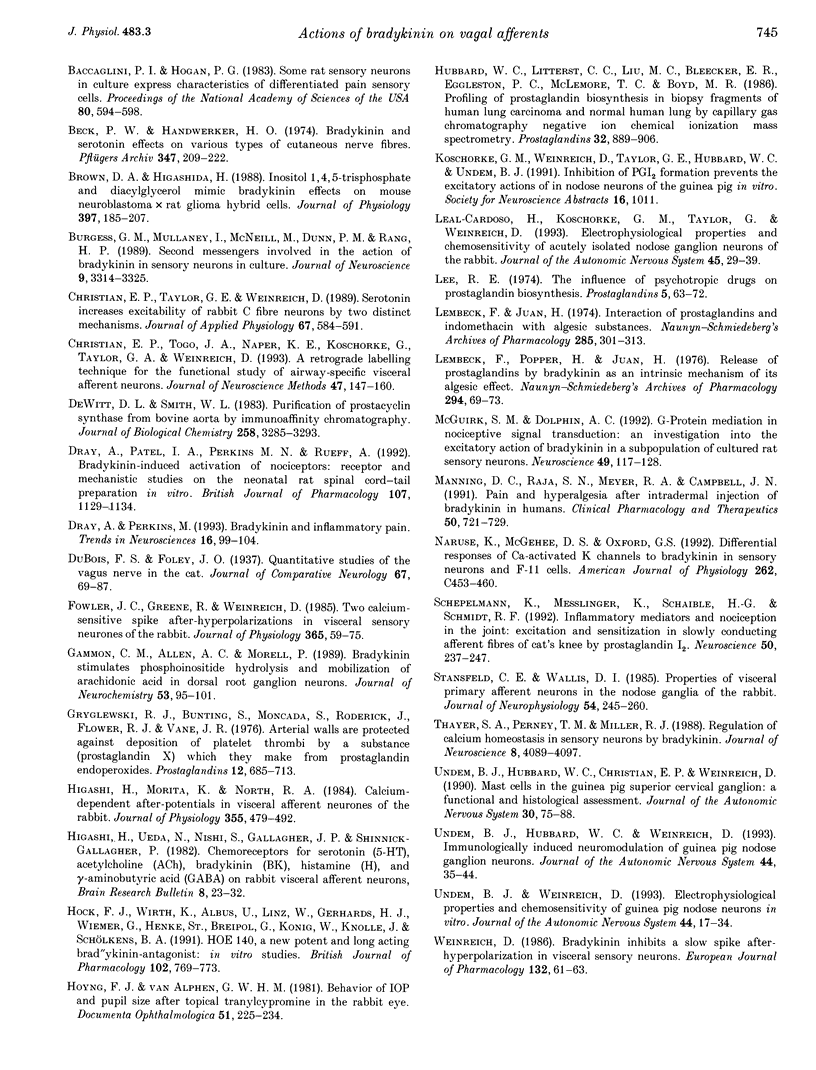

Selected References
These references are in PubMed. This may not be the complete list of references from this article.
- ARMSTRONG D., JEPSON J. B., KEELE C. A., STEWART J. W. Pain-producing substance in human inflammatory exudates and plasma. J Physiol. 1957 Feb 15;135(2):350–370. doi: 10.1113/jphysiol.1957.sp005715. [DOI] [PMC free article] [PubMed] [Google Scholar]
- Baccaglini P. I., Hogan P. G. Some rat sensory neurons in culture express characteristics of differentiated pain sensory cells. Proc Natl Acad Sci U S A. 1983 Jan;80(2):594–598. doi: 10.1073/pnas.80.2.594. [DOI] [PMC free article] [PubMed] [Google Scholar]
- Beck P. W., Handwerker H. O. Bradykinin and serotonin effects on various types of cutaneous nerve fibers. Pflugers Arch. 1974 Mar 11;347(3):209–222. doi: 10.1007/BF00592598. [DOI] [PubMed] [Google Scholar]
- Brown D. A., Higashida H. Inositol 1,4,5-trisphosphate and diacylglycerol mimic bradykinin effects on mouse neuroblastoma x rat glioma hybrid cells. J Physiol. 1988 Mar;397:185–207. doi: 10.1113/jphysiol.1988.sp016995. [DOI] [PMC free article] [PubMed] [Google Scholar]
- Burgess G. M., Mullaney I., McNeill M., Dunn P. M., Rang H. P. Second messengers involved in the mechanism of action of bradykinin in sensory neurons in culture. J Neurosci. 1989 Sep;9(9):3314–3325. doi: 10.1523/JNEUROSCI.09-09-03314.1989. [DOI] [PMC free article] [PubMed] [Google Scholar]
- Christian E. P., Taylor G. E., Weinreich D. Serotonin increases excitability of rabbit C-fiber neurons by two distinct mechanisms. J Appl Physiol (1985) 1989 Aug;67(2):584–591. doi: 10.1152/jappl.1989.67.2.584. [DOI] [PubMed] [Google Scholar]
- Christian E. P., Togo J. A., Naper K. E., Koschorke G., Taylor G. A., Weinreich D. A retrograde labeling technique for the functional study of airway-specific visceral afferent neurons. J Neurosci Methods. 1993 Apr;47(1-2):147–160. doi: 10.1016/0165-0270(93)90031-l. [DOI] [PubMed] [Google Scholar]
- DeWitt D. L., Smith W. L. Purification of prostacyclin synthase from bovine aorta by immunoaffinity chromatography. Evidence that the enzyme is a hemoprotein. J Biol Chem. 1983 Mar 10;258(5):3285–3293. [PubMed] [Google Scholar]
- Dray A., Patel I. A., Perkins M. N., Rueff A. Bradykinin-induced activation of nociceptors: receptor and mechanistic studies on the neonatal rat spinal cord-tail preparation in vitro. Br J Pharmacol. 1992 Dec;107(4):1129–1134. doi: 10.1111/j.1476-5381.1992.tb13418.x. [DOI] [PMC free article] [PubMed] [Google Scholar]
- Dray A., Perkins M. Bradykinin and inflammatory pain. Trends Neurosci. 1993 Mar;16(3):99–104. doi: 10.1016/0166-2236(93)90133-7. [DOI] [PubMed] [Google Scholar]
- Fowler J. C., Greene R., Weinreich D. Two calcium-sensitive spike after-hyperpolarizations in visceral sensory neurones of the rabbit. J Physiol. 1985 Aug;365:59–75. doi: 10.1113/jphysiol.1985.sp015759. [DOI] [PMC free article] [PubMed] [Google Scholar]
- Gammon C. M., Allen A. C., Morell P. Bradykinin stimulates phosphoinositide hydrolysis and mobilization of arachidonic acid in dorsal root ganglion neurons. J Neurochem. 1989 Jul;53(1):95–101. doi: 10.1111/j.1471-4159.1989.tb07299.x. [DOI] [PubMed] [Google Scholar]
- Gryglewski R. J., Bunting S., Moncada S., Flower R. J., Vane J. R. Arterial walls are protected against deposition of platelet thrombi by a substance (prostaglandin X) which they make from prostaglandin endoperoxides. Prostaglandins. 1976 Nov;12(5):685–713. doi: 10.1016/0090-6980(76)90047-2. [DOI] [PubMed] [Google Scholar]
- Higashi H., Morita K., North R. A. Calcium-dependent after-potentials in visceral afferent neurones of the rabbit. J Physiol. 1984 Oct;355:479–492. doi: 10.1113/jphysiol.1984.sp015433. [DOI] [PMC free article] [PubMed] [Google Scholar]
- Higashi H., Ueda N., Nishi S., Gallagher J. P., Shinnick-Gallagher P. Chemoreceptors for serotonin (5-HT), acetylcholine (ACh), bradykinin (BK), histamine (H) and gamma-aminobutyric acid (GABA) on rabbit visceral afferent neurons. Brain Res Bull. 1982 Jan;8(1):23–32. doi: 10.1016/0361-9230(82)90023-5. [DOI] [PubMed] [Google Scholar]
- Hock F. J., Wirth K., Albus U., Linz W., Gerhards H. J., Wiemer G., Henke S., Breipohl G., König W., Knolle J. Hoe 140 a new potent and long acting bradykinin-antagonist: in vitro studies. Br J Pharmacol. 1991 Mar;102(3):769–773. doi: 10.1111/j.1476-5381.1991.tb12248.x. [DOI] [PMC free article] [PubMed] [Google Scholar]
- Hoyng P. F., van Alphen G. W. Behaviour of IOP and pupil size after topical tranylcypromine in the rabbit eye. Doc Ophthalmol. 1981 Jul 15;51(3):225–234. doi: 10.1007/BF00143886. [DOI] [PubMed] [Google Scholar]
- Hubbard W. C., Litterst C. L., Liu M. C., Bleecker E. R., Eggleston J. C., McLemore T. L., Boyd M. R. Profiling of prostaglandin biosynthesis in biopsy fragments of human lung carcinomas and normal human lung by capillary gas chromatography-negative ion chemical ionization mass spectrometry. Prostaglandins. 1986 Dec;32(6):889–906. doi: 10.1016/0090-6980(86)90097-3. [DOI] [PubMed] [Google Scholar]
- Leal-Cardoso H., Koschorke G. M., Taylor G., Weinreich D. Electrophysiological properties and chemosensitivity of acutely isolated nodose ganglion neurons of the rabbit. J Auton Nerv Syst. 1993 Oct;45(1):29–39. doi: 10.1016/0165-1838(93)90359-3. [DOI] [PubMed] [Google Scholar]
- Lee R. E. The influence of psychotropic drugs on prostaglandin biosynthesis. Prostaglandins. 1974 Jan 10;5(1):63–68. doi: 10.1016/s0090-6980(74)80132-2. [DOI] [PubMed] [Google Scholar]
- Lembeck F., Juan H. Interaction of prostaglandins and indomethacin with algesic substances. Naunyn Schmiedebergs Arch Pharmacol. 1974;285(4):301–313. doi: 10.1007/BF00501460. [DOI] [PubMed] [Google Scholar]
- Lembeck F., Popper H., Juan H. Release of prostaglandins by bradykinin as an intrinsic mechanism of its algesic effect. Naunyn Schmiedebergs Arch Pharmacol. 1976 Jul;294(1):69–73. doi: 10.1007/BF00692786. [DOI] [PubMed] [Google Scholar]
- Manning D. C., Raja S. N., Meyer R. A., Campbell J. N. Pain and hyperalgesia after intradermal injection of bradykinin in humans. Clin Pharmacol Ther. 1991 Dec;50(6):721–729. doi: 10.1038/clpt.1991.212. [DOI] [PubMed] [Google Scholar]
- McGuirk S. M., Dolphin A. C. G-protein mediation in nociceptive signal transduction: an investigation into the excitatory action of bradykinin in a subpopulation of cultured rat sensory neurons. Neuroscience. 1992 Jul;49(1):117–128. doi: 10.1016/0306-4522(92)90079-h. [DOI] [PubMed] [Google Scholar]
- Naruse K., McGehee D. S., Oxford G. S. Differential responses of Ca-activated K channels to bradykinin in sensory neurons and F-11 cells. Am J Physiol. 1992 Feb;262(2 Pt 1):C453–C460. doi: 10.1152/ajpcell.1992.262.2.C453. [DOI] [PubMed] [Google Scholar]
- Schepelmann K., Messlinger K., Schaible H. G., Schmidt R. F. Inflammatory mediators and nociception in the joint: excitation and sensitization of slowly conducting afferent fibers of cat's knee by prostaglandin I2. Neuroscience. 1992 Sep;50(1):237–247. doi: 10.1016/0306-4522(92)90395-i. [DOI] [PubMed] [Google Scholar]
- Stansfeld C. E., Wallis D. I. Properties of visceral primary afferent neurons in the nodose ganglion of the rabbit. J Neurophysiol. 1985 Aug;54(2):245–260. doi: 10.1152/jn.1985.54.2.245. [DOI] [PubMed] [Google Scholar]
- Thayer S. A., Perney T. M., Miller R. J. Regulation of calcium homeostasis in sensory neurons by bradykinin. J Neurosci. 1988 Nov;8(11):4089–4097. doi: 10.1523/JNEUROSCI.08-11-04089.1988. [DOI] [PMC free article] [PubMed] [Google Scholar]
- Undem B. J., Hubbard W. C., Christian E. P., Weinreich D. Mast cells in the guinea pig superior cervical ganglion: a functional and histological assessment. J Auton Nerv Syst. 1990 Apr;30(1):75–87. doi: 10.1016/0165-1838(90)90164-e. [DOI] [PubMed] [Google Scholar]
- Undem B. J., Hubbard W., Weinreich D. Immunologically induced neuromodulation of guinea pig nodose ganglion neurons. J Auton Nerv Syst. 1993 Jul;44(1):35–44. doi: 10.1016/0165-1838(93)90376-6. [DOI] [PubMed] [Google Scholar]
- Undem B. J., Weinreich D. Electrophysiological properties and chemosensitivity of guinea pig nodose ganglion neurons in vitro. J Auton Nerv Syst. 1993 Jul;44(1):17–33. doi: 10.1016/0165-1838(93)90375-5. [DOI] [PubMed] [Google Scholar]
- Weinreich D. Bradykinin inhibits a slow spike afterhyperpolarization in visceral sensory neurons. Eur J Pharmacol. 1986 Dec 2;132(1):61–63. doi: 10.1016/0014-2999(86)90010-5. [DOI] [PubMed] [Google Scholar]
- Weinreich D., Wonderlin W. F. Inhibition of calcium-dependent spike after-hyperpolarization increases excitability of rabbit visceral sensory neurones. J Physiol. 1987 Dec;394:415–427. doi: 10.1113/jphysiol.1987.sp016878. [DOI] [PMC free article] [PubMed] [Google Scholar]


